DIR/Floortime, a pioneering approach to speech therapy, is gaining significant recognition for its effectiveness in fostering the development of communication skills in children with developmental challenges. By emphasizing child-led play and nurturing relationships, this therapeutic model goes beyond traditional speech therapy techniques, focusing on the holistic development of the child. Its innovative approach of integrating social-emotional skills, motor skills, and sensory integration piques interest and invites further exploration into its potential implications and benefits for both practitioners and beneficiaries.
Key Takeaways
- DIR/Floortime therapy enhances speech and language skills through child-led interactive play and nurturing social communication.
- The approach creates a captivating environment promoting language growth and effective communication of needs and emotions.
- It aids in expanding communication circles, contributing to the progress in achieving speech milestones.
- Parent involvement in the DIR/Floortime model strengthens parent-child relationships and fosters enhanced speech and language skills.
- The comprehensive assessment with a tailored approach in DIR/Floortime can significantly improve a child’s speech, language, and feeding abilities.
Understanding DIR/Floortime
DIR/Floortime, a therapy approach that originates from the core of relationship-based interventions, is specially crafted for children, particularly those diagnosed with autism. Devised by Stanley Greenspan, M.D. and Serena Wieder, PhD in the 1980s, this model primarily concentrates on achieving developmental milestones and fostering emotional and cognitive growth.
At the core of this model lies the principle of child-guided play, where interaction is crucial. This principle aligns with the advantages of play-based therapy as it boosts cognitive development and supports emotional comprehension. Floortime aims to broaden communication circles and strengthen the child’s abilities at their developmental level. This is accomplished by following the child’s lead, immersing oneself in their world, and engaging with them in a manner that resonates with them. The approach is exceptional in its emphasis on nurturing relationships and emotional bonds.
Professionals such as child psychologists, speech therapists, and special education teachers offer DIR/Floortime services. They skillfully lead children through this approach, ensuring that it is customized to the child’s distinct requirements and capabilities. In this manner, DIR/Floortime provides a caring and encouraging setting that motivates children to realize their full potential. Therefore, this method highlights the influence of relationships and interaction in developmental advancement.
Beneficiaries of DIR/Floortime

The beneficiaries of DIR/Floortime extend to a wide range of children facing developmental challenges. This therapy method, with its emphasis on Developmental, specific differences, and Relationship-based principles, has been incredibly impactful in enhancing communication abilities in autistic children and those experiencing speech delays. Meaningful play supports growth in motor skills, sensory integration, and social-emotional skills. In the following discussion, we will examine how this approach contributes to their development and addresses their specific needs.
Autistic Children’s Development
Notably, children with autism are among the primary beneficiaries of DIR/Floortime, with numerous improvements noticed in their speech and language abilities. The DIR/Floortime method involves interactive play, nurturing growth in social communication skills vital for everyday interactions.
This approach aids children with autism in effectively conveying their needs and emotions, necessary for their well-being and mental health. Additionally, DIR/Floortime highlights the importance of expanding communication circles for children with autism, thereby enriching their language development and fostering a sense of belonging.
Here’s a glimpse of the benefits children with autism gain from DIR/Floortime:
| Area of Enhancement | Advantage | Outcome |
|---|---|---|
| Speech and Language Skills | Improved through interactive play | More efficient communication |
| Social Communication Abilities | Cultivated for daily interactions | Stronger social connections |
| Language Development | Broadened communication circles | Improved ability to express needs & emotions |
The progress in speech and language milestones observed in children with autism participating in DIR/Floortime validates its effectiveness. This method plays an essential role in their developmental expedition, nurturing a better comprehension of their distinct world and enriching their ability to connect with those around them.
Addressing Speech Delays
Children experiencing speech delays often encounter barriers in their communication and social interactions. However, these barriers can be overcome using the DIR/Floortime approach in speech therapy. This method, rooted in developmental, personalized, and relationship-based principles, is effective because it focuses on a child’s holistic development, encouraging communication and language growth.
Incorporating floor play activities, the DIR/Floortime approach fosters sensory development and motor skills, which are vital in effective communication. These child-led interactions create an environment where children feel accepted and understood, fostering emotional connections that improve language development. Play-based interactions are necessary in this approach, providing opportunities for children to enhance their social communication skills. As they engage in play, they naturally begin to express themselves, breaking down the barriers of speech delays.
Speech therapists who incorporate DIR/Floortime principles provide a supportive framework for children to develop speech and language skills. The relationship-based approach of DIR/Floortime improves the outcomes of speech therapy, addressing communication challenges in a caring and efficient way.
DIR/Floortime Versus ABA

Exploring the landscape of speech therapy interventions often encounters two divergent paths: DIR/Floortime and Applied Behavior Analysis (ABA). Each offers distinct strategies to assist children with developmental challenges. DIR/Floortime primarily centers on relationship-based therapy and child-led play, fostering independent interactions and the development of social skills. Here, techniques such as puppet play and role-playing, often found in play therapy, can be utilized to express thoughts and feelings, enhancing social interaction skills.
In contrast, ABA emphasizes behavior modification through a more structured, disciplined approach. This method aligns with structured interaction games and activities that focus on cooperation and patience, akin to behavior-focused therapeutic interventions. The two methods, while different, share the common goal of enhancing children’s communication abilities.
DIR/Floortime aims to broaden communication circles and highlight emotional development, inviting the child to lead interactions at their own pace. ABA, on the other hand, utilizes a systematic approach to modify behavior, often following a detailed behavioral intervention plan.
The choice between DIR/Floortime and ABA is not a one-size-fits-all decision. It largely depends on individual preferences and needs, with some families opting for a combined approach for comprehensive support. Integrated approaches that incorporate elements of both DIR/Floortime and ABA can offer a balanced intervention strategy, creating a caring environment where every child feels a sense of belonging and is enabled to thrive.
Skill Point Therapy Services
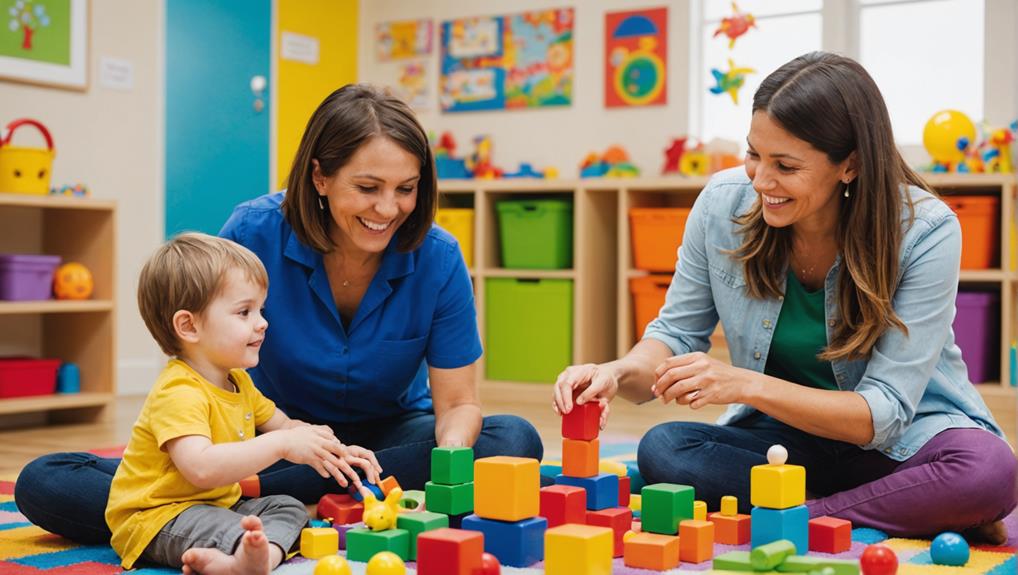
At Skill Point Therapy, pediatric speech therapy services (and pediatric occupational therapy) are customized to address each child’s distinct requirements, concentrating on improving communication skills. Skill Point Therapy utilizes sensory integration methods and individualized interventions to enhance the children’s focus and involvement in the therapy process. This is accomplished through a range of evidence-based speech therapy approaches. Furthermore, Skill Point Therapy adopts a multidisciplinary strategy, combining speech therapy with other therapeutic services like occupational therapy, which plays an essential role in designing personalized activities. These services offer thorough care, aiding children in reaching their maximum capabilities.
Speech Therapy Techniques
In speech therapy, Skill Point Therapy utilizes the DIR/Floortime technique to provide exceptional services to children facing challenges with speech and language delays. This distinct approach leverages interactive play-based activities crafted to enrich children’s speech, language, and communication skills. Among the variety of activities utilized, outdoor play has proven particularly advantageous in promoting children’s interaction and engagement in therapy.
With a powerful combination of child-led play and structured interventions, the speech therapists at Skill Point Therapy skillfully customize activities to each child’s individual needs and interests. This child-centered approach enables the establishment of a therapeutic environment that enhances expressive language abilities and improves articulation and vocabulary.
Furthermore, the DIR/Floortime technique facilitates a notable enhancement in social communication skills. This is accomplished by incorporating the child’s natural interests and motivating them to participate and interact more willingly. For example, integrating aspects of nature-inspired crafting can ignite a child’s imagination and refine their fine motor skills, enriching their overall therapeutic journey.
The primary objective of the speech therapy services at Skill Point Therapy is to assist children in realizing their complete communication potential. This is achieved through a caring, skilled, and inclusive approach that fosters a sense of belonging in every child, thereby nurturing their holistic growth and development.
Enhancing Communication Skills
Utilizing the proven DIR/Floortime principles, Skill Point Therapy’s speech therapy services skillfully improve communication skills in children. This approach, focusing on the child’s individual needs and developmental level, offers an effective tool to boost speech and language abilities. Skill Point Therapy’s approach is a Relationship-based model that expands communication circles, fostering meaningful interactions and promoting progress.
| Focus Area | DIR/Floortime Approach | Benefits |
|---|---|---|
| Speech | Interactive sessions tailored to the child’s specific needs | Improved articulation and fluency |
| Language | Activities designed to broaden vocabulary and comprehension | Enriched expression and understanding |
| Communication | Encouraging meaningful interactions | Cultivated social skills and self-confidence |
Skill Point Therapy’s speech therapy services offer a compassionate, engaging environment where every child feels a sense of belonging. The sessions are not just about improving speech but about understanding the child’s world and helping them express themselves in it. This approach is especially beneficial for children with developmental challenges, aiding them in achieving their communication goals. Skill Point Therapy’s dedication to the DIR/Floortime principles guarantees every child receives the opportunity to improve their communication skills effectively.
Skill Point Therapy’sSkill Point Therapy’s Multidisciplinary Approach
Skill Point Therapy adopts a holistic, multidisciplinary approach that integrates speech therapy, occupational therapy, and physical therapy. This model is designed to address the diverse needs of children, providing inclusive, integrated care to enrich their overall growth. By applying tailored sensory activities and therapeutic play, they also aim to nurture sensory integration and better engagement in children with sensory processing variances.
The core of their approach lies in improving speech and communication skills, boosting motor skills, and increasing independence. Simultaneously, they work on enhancing social interaction and implementing effective behavioral interventions. The team at Skill Point Therapy is committed to providing quality services that adhere to confidentiality, legal, and ethical standards. They believe that every child is unique and deserves individualized care, fostering a sense of belonging and acceptance.
Through the implementation of a structured sensory diet, Skill Point Therapy aims to regulate sensory input and help children throughout the day. Skill Point Therapy offers a monthly newsletter subscription to keep parents and caregivers informed. This includes updates, tips, resources, events, and expert advice to guide and support families on their path. This inclusive model not only addresses the child’s needs but also equips families with knowledge and resources, creating a supportive community centered around the child’s growth and development. This multidisciplinary approach sets Skill Point Therapy apart from other pediatric therapy services, making them a trusted partner in the process of nurturing a child’s potential.
The Concept of Floortime

At the heart of the therapeutic approach known as Floortime lies a relationship-based model explicitly designed for children diagnosed with autism. The Floortime approach fosters a therapeutic bond between the child and adult, using an interactive play that aligns with the child’s developmental capacities.
Unlike traditional Applied Behavior Analysis (ABA) therapy, the DIR/Floortime model focuses on expanding communication circles and building on the child’s distinct strengths. This approach’s ultimate goal is to stimulate two-way communication, complex thought processes, and heartfelt thinking. This is achieved by carefully crafted sessions that typically range from 2 to 5 hours, designed to create a calm and engaging environment and enhance parent-child interaction.
Moreover, Floortime encourages inclusion with peers and cultivates shared attention through back-and-forth play. This approach is instrumental in promoting abstract and logical thinking skills and integrating the child into social norms. With its compassionate and relationship-centered approach, Floortime goes beyond traditional therapy, offering a sense of belonging and acceptance to children with autism and their families. This technique is an integral part of the holistic and inclusive approach to speech therapy.
Six Key Milestones
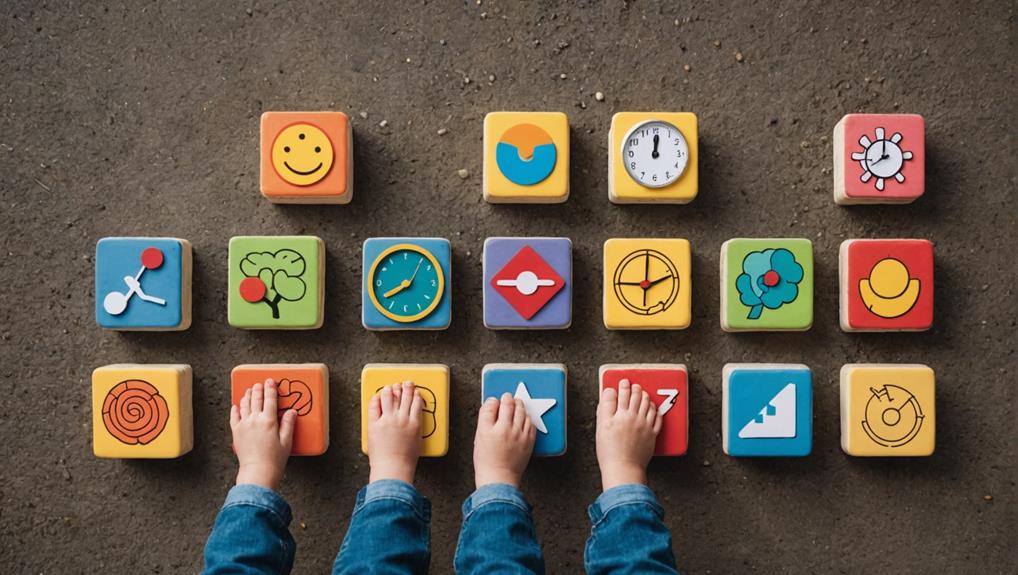
Floortime therapy revolves around six critical developmental milestones, each representing a pivotal stage in a child’s cognitive and affective development. These milestones are essential components of the DIR/Floortime principles and are designed to foster social and emotional development in children with autism and other developmental challenges.
The initial milestone revolves around self-regulation, a vital skill for maintaining emotional balance. The following milestone focuses on developing an interest in the world, encouraging curiosity and exploration. The subsequent milestone fosters intimacy in relationships, promoting the formation of strong emotional bonds. The fourth milestone emphasizes two-way communication, a crucial aspect of social interaction. The fifth milestone cultivates complex communication, enhancing the child’s ability to express thoughts and feelings. The final milestone nurtures emotional ideas and thinking, promoting cognitive development and emotional understanding.
| Milestone | Purpose | Targeted Skill |
|---|---|---|
| Self-Regulation | Maintaining Emotional Balance | Emotional Regulation |
| Interest in the World | Encouraging Curiosity | Exploration |
| Intimacy in Relationships | Forming Emotional Bonds | Relationship Building |
| Two-Way Communication | Social Interaction | Communication |
| Complex Communication | Expressing Thoughts & Feelings | Language Development |
| Emotional Ideas & Thinking | Promoting Cognitive Development | Emotional Understanding |
Mastering these milestones can significantly enhance a child’s communication, social skills, and emotional understanding, leading to a more enriching life experience.
Floortime Implementation
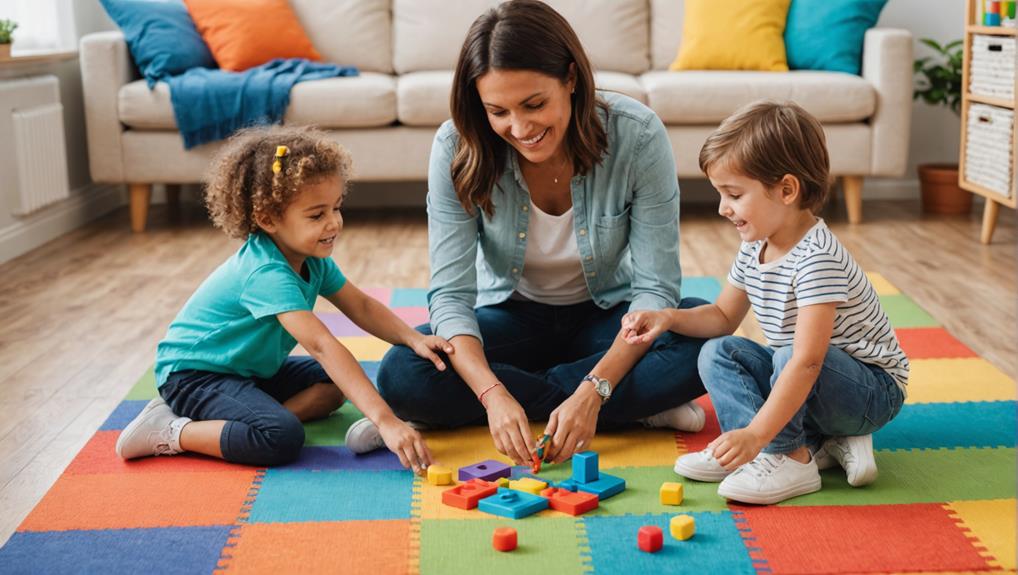
In speech therapy, Floortime is a distinctive approach that highlights child-led play in a serene and captivating setting. Its core advantages are nurturing communication skills and language growth through interactive exchanges. To optimize Floortime’s potential, it is essential to grasp its fundamentals, acknowledge its benefits, and utilize effective strategies that meet the individual requirements of the child.
Understanding Floortime Basics
Delving into the core of the Floortime approach reveals a unique method of speech therapy that utilizes the power of child-led play and interaction. The Floortime model focuses on following the child’s lead and challenging them at the appropriate level for speech development, thereby creating an environment where the child feels understood, valued, and a part of a shared world.
- The initial pillar of the Floortime model is child-led play. This creates a natural environment for children to express their thoughts and feelings, which is crucial for the development of speech and language skills.
- The following aspect involves expanding communication circles. This means engaging the child in back-and-forth communication, thereby broadening their interaction capacity and improving their speech abilities.
- The next feature of Floortime involves challenging the child at their level. This helps them to gradually enhance their speech and language skills without causing undue stress or anxiety.
- The overarching goal of Floortime is to enrich emotional interactions, which supports speech and language development and thus nurtures a sense of belonging.
Therefore, Floortime is an inclusive approach that promotes interactive play and communication while always respecting the child’s lead, making it an effective model for speech therapy.
Benefits of Floortime Therapy
Utilizing the power of play, Floortime therapy yields significant benefits, notably in promoting speech and language development. This therapeutic approach is recognized for its distinct emphasis on heartfelt interactions and challenging children at their functional level to stimulate speech growth. Through interactive play-based sessions, children with speech delays are able to engage in meaningful interactions that enrich their language skills.
Furthermore, Floortime focuses on expanding the child’s circles of communication, thereby strengthening social communication skills. By following the child’s lead during play, parents and caregivers can naturally discover and extend the child’s communicative attempts. This approach fosters a sense of belonging and inclusion, as it values and respects the child’s interests and feelings.
Vital research supports Floortime’s effectiveness in improving speech, communication, and social skills. Not only does it provide a platform for children with developmental challenges to express themselves, but it also equips parents and caregivers with practical strategies to continue supporting their children’s speech and language growth at home. The benefits of Floortime extend beyond therapy sessions, enabling families to promote continuous language development.
Effective Floortime Strategies
Moving forward from the numerous benefits of Floortime therapy, especially in speech development, it is essential to understand how to execute this therapeutic approach effectively. Implementing Floortime strategies effectively demands an understanding of the child’s interests and abilities, thereby fostering a profound sense of belonging and engagement in children with autism.
- Follow the child’s lead: Parents engage in the child’s play sessions, creating a platform for the child to communicate and interact.
- Use scaffolding techniques: This challenges children at the appropriate level, promoting skill development without overwhelming them.
- Expand circles of communication: Floortime strategies help extend the child’s communication skills through interactive interactions and shared experiences.
- Encourage back-and-forth play: This develops shared attention and mutual interaction, which is vital for speech and social development.
In essence, Floortime is not just about therapy. It’s about understanding your child’s world, entering it, sharing experiences, and promoting growth. As parents and therapists, our role is to foster an environment that nurtures engagement and communication, igniting the spark for further learning and development.
Real-life Floortime Example

To understand the practical application of Floortime, consider this actual-life example. In a typical home setting, parents become instrumental in helping children expand their communication and heartfelt abilities through playful interactions. A parent may join their child’s play activities, following the child’s lead and engaging in back-and-forth play.
This interactive method promotes shared attention and interaction, essential aspects of Floortime. The parent carefully matches strategies with the child’s interests to create a nurturing environment that fosters growth. Whether the child is building a tower with blocks or pretending to be a superhero, the parent becomes an active participant in the child’s world.
These regular, daily interactions help develop abstract and logical thinking skills, as the Floortime principles are subtly incorporated. By respecting and responding to the child’s emotional cues and interests, parents help to expand communication circles and foster deep, heartfelt connections.
Implementing Floortime in everyday scenarios is not just about teaching—it’s about creating a sense of belonging for the child and enhancing their distinct abilities. Consequently, parents play a pivotal role in shaping their child’s development through the application of Floortime principles.
Historical Background of Floortime
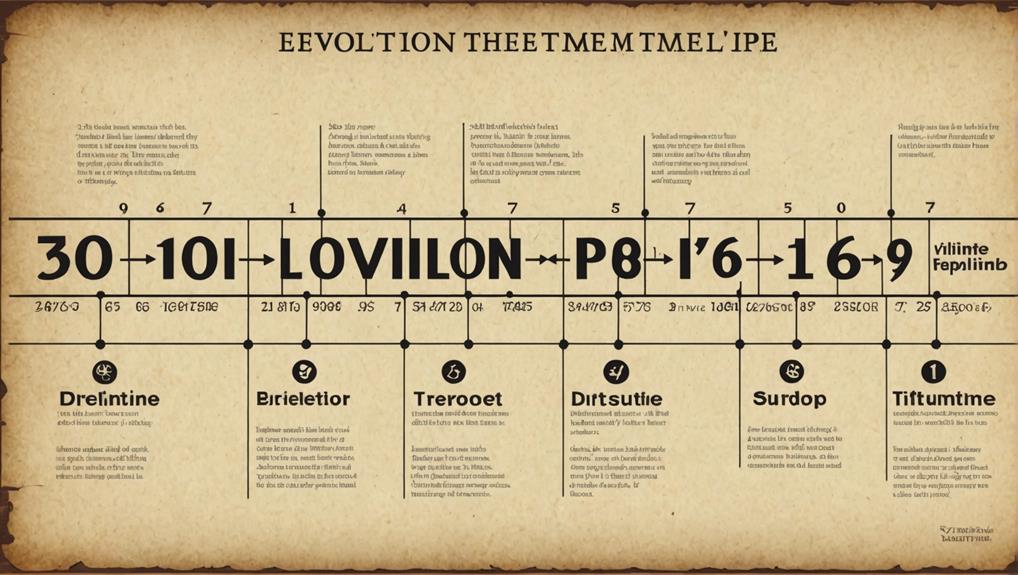
How did the concept of floortime originate? The historical backdrop of floortime is deeply rooted in a dedication to emotional growth and rapport building. Developed in the 1980s by Stanley Greenspan, MD, and Serena Wieder, PhD, floortime emerged from the Developmental, Personal Differences, Relationship-Based (DIR) model, a framework that highlights the significance of emotional interactions in promoting developmental milestones.
- The DIR model, which is the foundation of Floortime, accentuates the pivotal role of emotional development in fostering the growth of children with developmental challenges.
- Floortime was created to guarantee that children reach their full potential by focusing on building emotional connections with them.
- The approach was designed to encourage parents and caregivers to be active participants in their child’s therapy sessions, thereby fostering an environment of belonging.
- Floortime’s historical background underscores its commitment to relationship building as a fundamental aspect of the therapy process.
As we explore Floortime’s historical background, we acknowledge that its primary objective remains unchanged: to promote emotional growth and relationship building, thereby fostering a sense of belonging for every child.
Floortime Service Providers
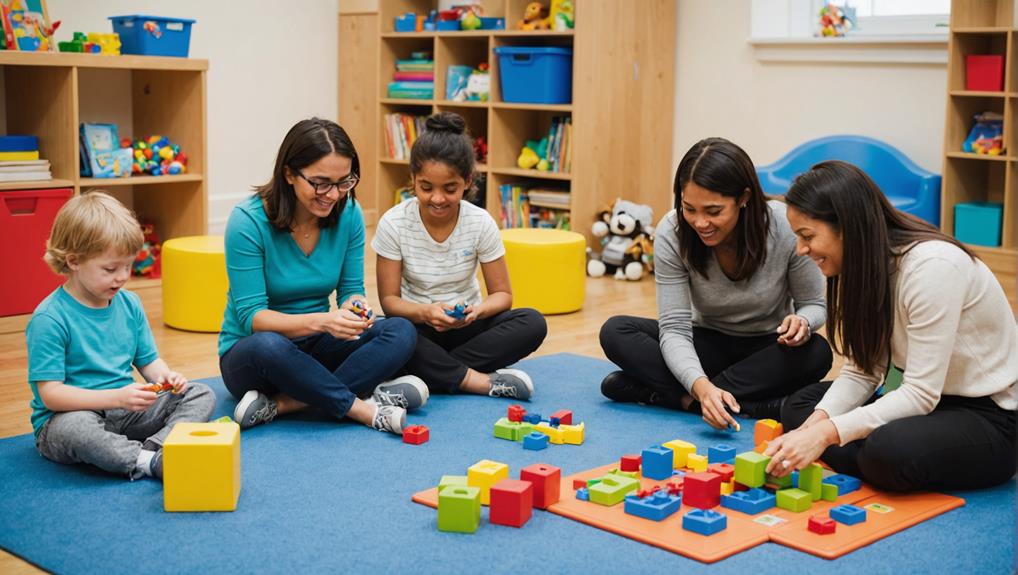
In Floortime, a wide array of professionals come into play as service providers. These include child therapists, educators specializing in special needs, speech pathologists, and occupational specialists, all of whom play essential roles in the child’s developmental expedition. Their collective knowledge and expertise in speech-language techniques are crucial in helping children improve their communication abilities.
Parents and caretakers, too, can be part of this circle of support. They can grasp and utilize Floortime methods, enabling them to provide consistent support of strategies at home, further elevating the child’s progress.
At the core of this approach are the DIR/Floortime certified professionals. They oversee the program, ensuring a cooperative environment where each expert brings their distinct skills to the table. This team of professionals collaborating nurtures a comprehensive approach that addresses the child’s varied needs.
Listings and organizations specializing in this field can facilitate the search for Floortime service providers. These platforms link families with certified practitioners, creating a community that appreciates and advocates for the Floortime approach. This sense of belonging can indeed be empowering for families maneuvering their child’s development voyage.
Comprehensive DIR/Floortime Assessment
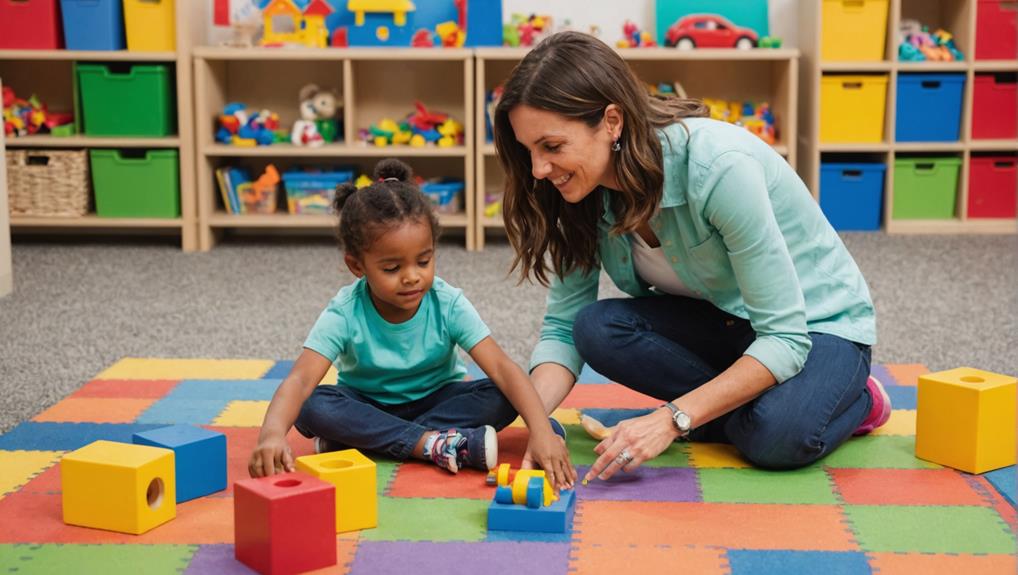
While the combined efforts of Floortime service providers are essential in a child’s developmental path, an equally significant factor is a deep understanding of each child’s specific needs and capabilities. For this purpose, the thorough DIR/Floortime assessment plays a crucial role. This assessment, filled with empathy and expertise, evaluates sensory processing, motor, and emotional processing systems in children, thereby facilitating early intervention.
The assessment offers four key benefits:
- It develops an Individual Profile for the child, understanding them comprehensively. This acknowledges the child’s distinct capacities and challenges, fostering a sense of inclusion.
- It guides parents in supporting their child’s development effectively, reducing uncertainty and fostering confidence.
- Parents are equipped to play a leading role in their child’s treatment, boosting their empowerment.
- Through the tailored support offered after the assessment, parents can improve their child’s speech, language, and feeding abilities.
In essence, the thorough DIR/Floortime assessment bridges the gap between professional support and understanding, creating a united front in the child’s developmental journey.
Parent Coaching in DIR/Floortime

Given the critical role parents play in their child’s developmental path, parent coaching in DIR/Floortime equips them to foster their child’s speech and language skills effectively. This enrichment process enables them to effectively nurture their child’s speech and language abilities, leading to strengthening the parent-child relationship, interactions, and connection through customized strategies, promoting meaningful interactions.
Parents can receive coaching in the DIR/Floortime model to improve their child’s speech and language development within this structured context. This coaching process encourages parents to form attachment relationships, which are vital for children’s thriving.
Here is a visual representation of the key points:
| Key Aspect | Benefit |
|---|---|
| Empowerment | Strengthens parent-child relationship |
| Customized strategies | Promotes meaningful interactions |
| DIR/Floortime model | Improves speech and language skills |
| Coaching process | Encourages attachment relationships |
| Attachment relationships | Crucial for children’s thriving |
Tailored Approach of DIR/Floortime
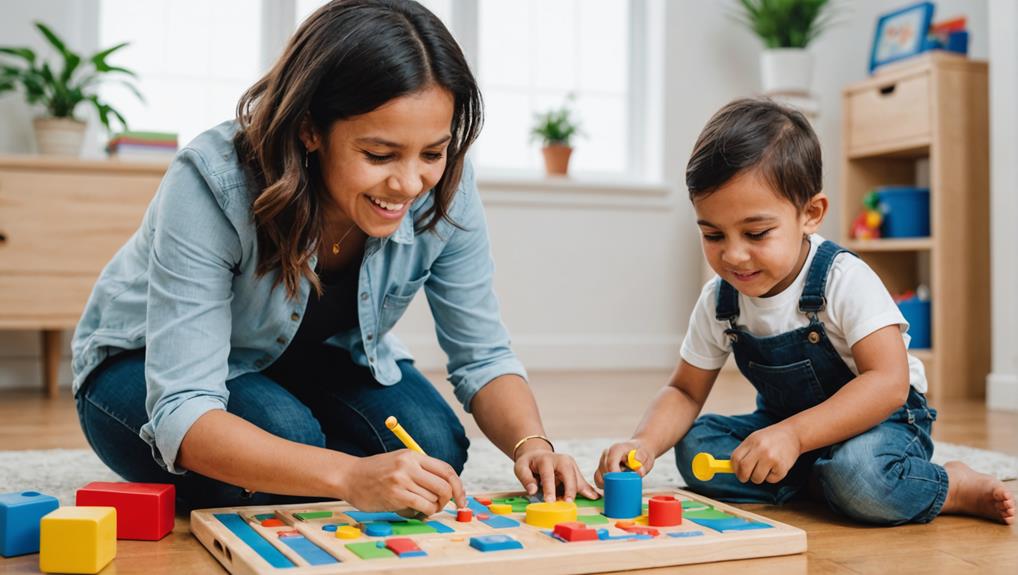
Embracing a specific facet of speech therapy, DIR/Floortime tailors its treatment plans to meet the individual requirements of each child. This personalized approach to treatment allows therapists to address the distinct needs of each child, whether typically developing or neurodiverse. The goal is to help children enhance their abilities to play and interact meaningfully, improving their speech, language, and feeding skills in the process.
- DIR/Floortime’s approach is not one-size-fits-all; it considers each child’s exceptional strengths and challenges, ensuring tailored care.
- The therapy sessions are designed to foster significant interactions, prioritizing the child’s heartfelt experiences to strengthen their speech and language skills.
- Strengthening of parents is a cornerstone of this approach. Through coaching, parents become influential allies in their child’s speech development journey while enhancing their relationship.
- Adapting to children’s needs, DIR/Floortime embodies an inclusive approach that caters to both typically developing children and those with diverse neurological conditions.
Frequently Asked Questions
How Does DIR/Floortime Support Speech Therapy?
DIR/Floortime helps speech therapy by encouraging natural communication through meaningful interactions. It focuses on building connections and addressing the child’s individual needs, fostering a foundation for expressive and receptive language.
Can DIR/Floortime Help Non-Verbal Children Communicate?
Yes, DIR/Floortime meets children where they are developmentally, encouraging non-verbal communication like gestures and sounds. These skills often evolve into verbal communication as relationships and interactions grow.
How Can Speech Therapy Improve Social Communication Skills?
Speech therapy teaches children how to use language in social contexts, like making eye contact or taking turns in conversations. It also helps them understand non-verbal cues, boosting confidence in social interactions.
What Strategies Are Used in DIR/Floortime Speech Therapy Sessions?
Therapists integrate speech goals into engaging activities using play-based and child-led interactions. This approach promotes language development through emotional connections and shared experiences.
Why Is DIR/Floortime Valuable in Pediatric Therapy?
DIR/Floortime emphasizes a child’s emotional and developmental needs, addressing the “why” behind challenges. It builds a robust and personalized framework for growth in communication, regulation, and relationships.
Conclusion
To sum up, DIR/Floortime embodies a game-changing approach to speech therapy. By emphasizing child-led play and relationship-building, this method nurtures communication, social-emotional skills, and comprehensive growth. The customized strategies and nurturing setting offer ideal conditions for children with developmental challenges to flourish. As research continues to confirm this method, it becomes more evident that DIR/Floortime is a crucial tool in enhancing the well-being of children dealing with speech and developmental delays.


Recent Comments